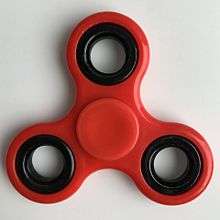Fidget spinner
 A typical three-lobed fidget spinner | |
| Type | Stress-relieving toy |
|---|---|
| Availability | 1993–present |
| Materials | Brass, stainless steel, ceramic, titanium, copper, plastics, etc. |
A fidget spinner is a skill toy that consists of a bearing in the center of a multi-lobed flat structure made from metal or plastic designed to spin along its axis with little effort.
Fidget spinners became popular toys in 2017, although similar devices had already been invented as early as 1993. The toy became popular among teenage people and consequently some schools banned the spinners for being a distraction, while other schools allowed the toy to be used discreetly.
The toy has been advertised as helping people who have trouble with focusing or fidgeting by relieving nervous energy or psychological stress. As of May 2017, there is no scientific evidence that they are effective as a treatment for autism or ADHD.[1][2]
Design

Fidget spinners are toys not unlike yo-yo or other skill toys, designed to spin with little effort.[3][4] A basic fidget spinner consists of a two- or three-pronged design with a bearing in its center circular pad.[4][5] A person holds the center pad while the toy spins.[5] They are made from various materials including brass, stainless steel, titanium, copper, aluminium, and plastic.[3][4] The bearings are generally ceramic, metal (stainless steel or chrome), and some are hybrids—such as ceramic balls with stainless races and cages. Each fidget spinner also has two or more weights on the outside that make it spin faster and stay balanced. Bearings can vary to adjust for the design's spin time, vibration, and noise, causing unique sensory feedback.
Origin
As of 2017, the patent status of the various fidget spinners on the market was unclear.[6]
Catherine Hettinger, a chemical engineer by training, was initially credited by some news stories to have been the inventor of the fidget spinner, including by media outlets such as The Guardian,[7] The New York Times,[8] and the New York Post.[9] Hettinger filed a patent application for a "spinning toy"[10] in 1993 and a patent was issued, but Hettinger allowed the patent to lapse in 2005 after she could not find a commercial partner.[7][6] A May 2017 Bloomberg News article showed that Hettinger was not the inventor of the fidget spinner, and Hettinger agreed.[6]
In an interview appearing on May 4, 2017 on NPR, Scott McCoskery described how he invented a metal spinning device in 2014 to cope with his own fidgeting in IT meetings and conference calls.[11] In response to requests from an online community, he began selling the device he called the Torqbar online.[11]
Marketing and sales

With the rapid increase in the spinner's popularity in 2017, many children and teenagers began using it in school, and some schools also reported that kids were trading and selling the spinner toys.[12][13][14]
As a result of their frequent use by schoolchildren, many school districts banned the toy.[7][8] Some teachers argued that the spinners distracted students from their school work.[12] According to a survey conducted by Alexi Roy and published in May 2017, 32% of the largest 200 American public and private high schools had banned spinners on campus.[15]
When fidget spinners rose in popularity in 2017, many publications in the popular press discussed the marketing claims made about them for people with ADHD, autism, or anxiety.[2][7][8] However, there is no scientific evidence that fidget spinners are effective as a treatment for children with autism or ADHD.[1][2][16]
See also
References
- 1 2 Calfas, Jennifer (May 11, 2017). "Do Fidget Spinners Really Help With ADHD? Nope, Experts Say". Money. Time. Retrieved May 16, 2017.
- 1 2 3 Singh, Anita; Horton, Helena; Fuller, George (May 3, 2017). "Fidget spinners: the new classroom craze being banned across the nation". The Telegraph. Retrieved May 16, 2017.
- 1 2 Arnett, Dugan (March 30, 2017). "Need to focus? Fidget toys may help.". The Boston Globe. Retrieved April 4, 2017.
- 1 2 3 Tuttle, Brad; O'Brien, Elizabeth (April 21, 2017). "Meet the Fidget Spinner, the New Toy Craze Entrancing Kids and Grownups Alike". Money. Retrieved April 22, 2017.
- 1 2 Verstegen, Dominic (April 21, 2017). "Your kid probably has a fidget spinner already, but let me tell you about it anyway". USA Today. Retrieved May 7, 2017.
- 1 2 3 Brustein, Joshua (May 11, 2017). "How the Fidget Spinner Origin Story Spun Out of Control". Bloomberg News. Retrieved May 12, 2017.
- 1 2 3 4 Luscombe, Richard (May 5, 2017). "As fidget spinner craze goes global, its inventor struggles to make ends meet". The Guardian. Retrieved 11 May 2017.
- 1 2 3 Williams, Alex (May 6, 2017). "How Fidget Spinners Became a Hula-Hoop for Generation Z". The New York Times.
- ↑ Miller, Joshua Rhett (May 5, 2017). "Woman who invented fidget spinners isn't getting squat". New York Post.
- ↑ US 5591062A, Catherine A. Hettinger, "Spinning toy", published 1997-01-07, issued 1997-01-07
- 1 2 Malone, Kenny (May 4, 2017). "Fidget Spinner Emerges As Must-Have Toy Of The Year". Planet Money. NPR. Retrieved May 18, 2017.
- 1 2 Calfas, Jennifer (May 4, 2017). "Here's Everything You Need To Know About Fidget Spinners". Money. Time. Retrieved May 6, 2017.
- ↑ "Many Schools Ban Hot Toy For Being Distraction". CBS Los Angeles. May 4, 2017. Retrieved May 6, 2017.
- ↑ "Fidget Spinners For Kids: Reports Say It's Distracting, Parents Say Not So". CBS Miami. May 2, 2017. Retrieved May 7, 2017.
- ↑ Roy, Alexi (May 10, 2017). "The Fidget Spinners Are Banned in 32% of the Largest High Schools U.S.". Spinner List.
- ↑ Bogost, Ian. "The Fidget Spinner Explains the World". The Atlantic. Retrieved 2017-07-09.
| Wikimedia Commons has media related to Fidget spinners. |